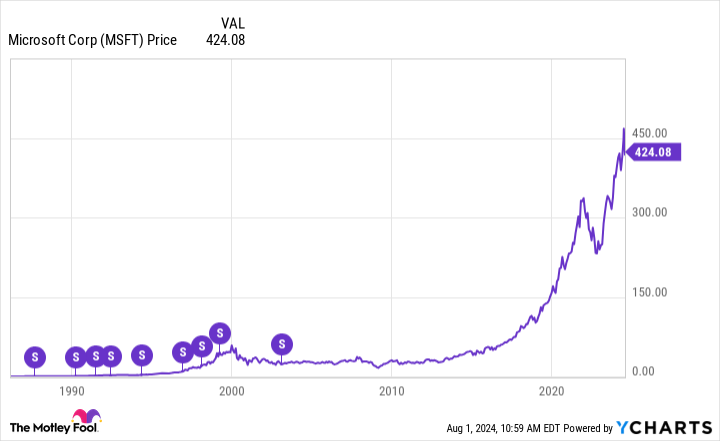
2024-08-06 20:20:02
The company hasn’t split its stock since Azure took Microsoft into a new growth era.
Tech giant Microsoft (MSFT 1.81%) has been around for a long time, so it’s no stranger to stock splits. The company split its stock nine times from the late 1980s to the early 2000s. But since then? Nada. Today, Microsoft stock is trading at over $400 per share. Cloud and artificial intelligence (AI) growth has driven shares to new heights and could continue over the long term.
Perhaps it’s time for management to consider a stock split.
What does that mean for investors? Would a stock split make Microsoft a buy?
Here is what you need to know.
What do stock splits mean for you?
The media loves making a big deal out of stock splits. But are they as big a deal as they seem?
First, what is a stock split? A stock split is when a company divides its stock to increase the number of shares. Suppose one share of a company’s stock trades at $100. If management did a 5-to-1 split, that single share would become five shares trading at $20 each.
Notice how the value of the investment didn’t change. One share at $100 or five at $20 equals the same total. This is very important.
Stock splits divide everything, so each share represents less of the company’s revenue, profits, and equity. So, while a stock split creates a lower share price, it’s an illusion. The company’s fundamental valuation doesn’t change.
So why split the stock in the first place? In most cases, it’s for liquidity. As a share price rises, it’s harder for investors to accumulate shares without having a lot of money. Employees who have earned stock-based compensation might be sitting on significant gains and may not want to sell at high dollar increments. A higher share count and lower share price make it easier for investors and employees to control how much they buy or sell at a time.
Why a stock split makes sense for Microsoft
You can see that Microsoft split several times between the late 1980s and the early 2000s. That was due to remarkable stock performance; Microsoft gained nearly 60,000% from 1986 to 2000, just before the Dot-Com market crash. Microsoft’s stock plunged in the crash and took 17 years to reach the price it traded at in 2000. That’s why Microsoft has only split once since 2000.
Microsoft launched its cloud platform Azure in early 2010, sparking a new era for the company. Since then, Microsoft’s stock has appreciated 1,400%, and the cloud is its largest and fastest-growing business unit today. A new generation of employees who have been with the company over the years are likely sitting on hefty stock gains.
Azure is already the world’s second-leading cloud platform. Microsoft’s partnership with leading AI developer OpenAI is poised to funnel AI computing workloads through Azure as companies adopt AI over the coming years.
Is Microsoft a buy?
Microsoft recently reported fourth-quarter earnings for its fiscal year 2024 and topped Wall Street’s expectations, fueled by solid momentum in its cloud and gaming businesses. Today, Microsoft stock trades at 32 times its estimated 2025 earnings. Analysts believe earnings per share will grow at an annualized 16% rate for the next three to five years.
Since stock splits don’t fundamentally change the stock, investors should never make an investment decision based solely on a stock split. A price-to-earnings ratio double the company’s earnings growth percentage isn’t cheap, but Microsoft arguably offers a unique combination of quality and upside that’s hard to replicate.
Long-term investors may be willing to pay a slight premium to own the stock now, though market volatility could easily present better buying opportunities.
Justin Pope has no position in any of the stocks mentioned. The Motley Fool has positions in and recommends Microsoft. The Motley Fool recommends the following options: long January 2026 $395 calls on Microsoft and short January 2026 $405 calls on Microsoft. The Motley Fool has a disclosure policy.




